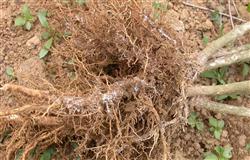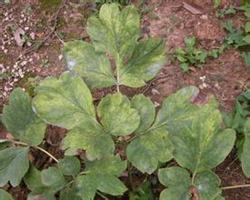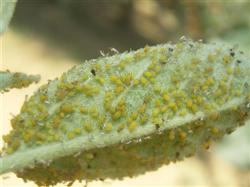Peony planting: what is peony white silk disease?

What is peony white silk disease? What is the harm of peony white silk disease? How to control the harm of peony white silk disease: the disease mainly occurs at the stem base of the seedling near the ground. At the beginning, the cortex of the diseased part turned brown, gradually developed around, and produced white silk-like hyphae in the diseased part, which fanned and spread to the nearby soil surface, and later formed rapeseed-like tea-brown sclerotia on the basal surface or on the mycelium layer of the soil surface. After the seedling was infected, the cortex of the stem base and root rotted, the transport of water and nutrients of the plant was cut off, the leaves turned yellow and withered, and the whole plant withered. The incidence time and cause of peony white silk disease: in the Yangtze River basin, the disease generally began to occur in early June, the disease was in the peak period from July to August, and basically stopped after September. Under the condition of 18-28 ℃ and high humidity, it took only 8-9 days from sclerotia germination to supreme new sclerotia formation, and about 9 days from sclerotia formation to maturity. The conditional pathogen preferred high temperature and humidity, and the development stopped when the optimum growth temperature was 30: 35 ℃ and higher than 40 ℃. Soil PH5~7 is suitable for disease occurrence, but it is rare in alkaline soil. The soil is rich in humus, high in nitrogen content, heavy soil viscosity and relatively sour garden, and the incidence is high. Prevention and control methods of peony white silk disease: 1. In order to prevent the disease at the seedling stage, 70% pentachloronitrobenzene powder can be used to treat the soil, 250 grams per 67 square meters, 5 kg of dry fine soil, mixed evenly, and sprinkled in the sowing or cutting ditch. Then sow or cut. 2. In the early stage of the disease, 70% pentachloronitrobenzene powder can be sprinkled on the soil surface in the nursery. 250g of pentachloronitrobenzene powder is used every 67 square meters. After application, the soil is loosened and the powder is evenly mixed into the soil. 50% carbendazim wettable powder 500ml 800 times solution, or 50% carbendazim wettable powder 500x solution, or 1% copper sulfate solution, or verapamil 10ppm, or chlorpromazine 25ppm, irrigate the roots of the seedlings to control the spread of the disease. 3. After the symptoms appear in the aboveground part of the tree body in spring and autumn, the soil near the main root of the trunk can be removed to dry, which can restrain the development of the disease. The time of root drying can be carried out from early spring to March to autumn until the leaves fall, and the tree holes can be filled before the rainy season to prevent adverse effects. When drying the roots, we should also pay attention to building a ridge around the hole to prevent water from flowing into the hole. 4. When selecting disease-free seedlings and transporting seedlings, strict inspection should be carried out, disinfecting healthy seedlings and removing diseased seedlings. The disinfectant can be soaked in 70% thiophanate methyl or carbendazim 800 × 1000 times, 2% lime water, 0.5% copper sulfate solution for 10 minutes, and then planted. It can also be soaked in 45 ℃ warm water for 20 minutes to kill root germs. 5. After the diseased tree is determined to be sick according to the symptoms of the aboveground part of the tree, peel off the soil at the base of the tree trunk to find the disease site. After the disease is diagnosed as white silk disease, scrape the root neck spot thoroughly with a knife, and disinfect the wound with 50 times of antibacterial agent 401 or 1% sulfuric acid solution, then apply Bordeaux paste and other protective agents, and then cover the new soil. Click to get more peony planting techniques click to get more flower planting techniques
- Prev

Peony planting: how can peony prevent and cure virus disease?
How does peony flower prevent and cure virus disease? What harm does viral disease have to peony flowers? Please introduce the harm of the virus disease to peony flowers: peony ringspot virus produces concentric round spots with the same dark green and light green on the leaves, as well as small necrotic spots, plants are not dwarfed, and TRV changes in different sizes.
- Next

Peony planting: what are the peony diseases and insect pests?
What are the diseases and insect pests of peony flowers? How to control these diseases and insect pests? Please guide the common pests of peony flowers are aphids, leaf rollers and cabbage insects; the common diseases of peony flowers are soft rot and downy mildew; detailed control methods can be listed as follows: 1.
Related
- Fuxing push coffee new agricultural production and marketing class: lack of small-scale processing plants
- Jujube rice field leisure farm deep ploughing Yilan for five years to create a space for organic food and play
- Nongyu Farm-A trial of organic papaya for brave women with advanced technology
- Four points for attention in the prevention and control of diseases and insect pests of edible fungi
- How to add nutrient solution to Edible Fungi
- Is there any good way to control edible fungus mites?
- Open Inoculation Technology of Edible Fungi
- Is there any clever way to use fertilizer for edible fungus in winter?
- What agents are used to kill the pathogens of edible fungi in the mushroom shed?
- Rapid drying of Edible Fungi

